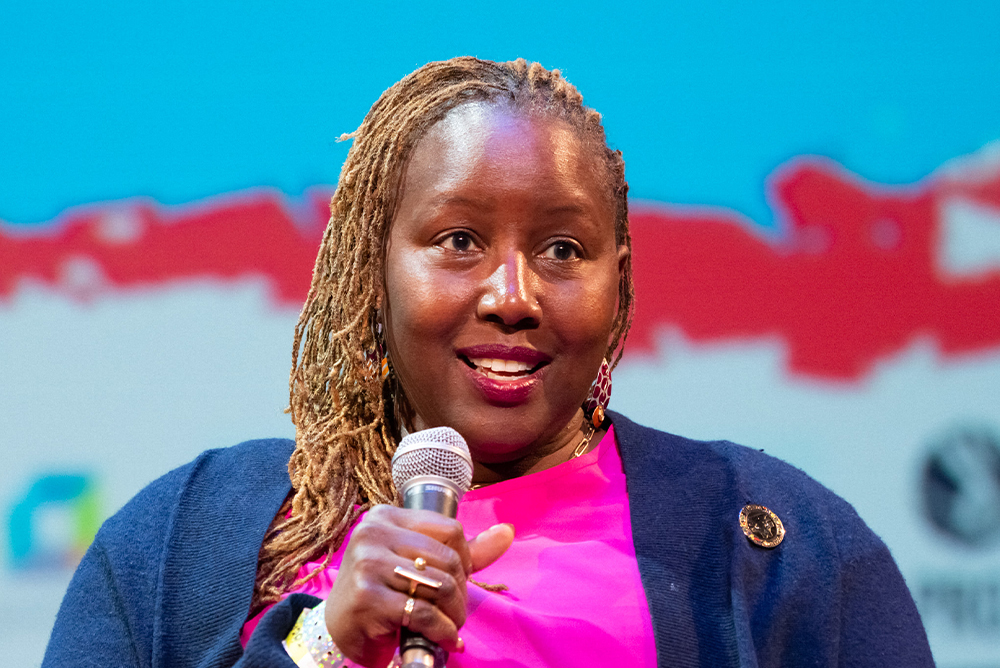
Photo by Aaron Perez.
Nataki Garrett is the co-artistic director of One Nation/One Project and the national Arts and Health initiative #ArtsforEveryBody. She was the sixth artistic director of the Oregon Shakespeare Festival–the first Black woman in the role–and the first executive artistic director of the organization. Before taking part in the Zócalo, Thomas Mann House, and L.A. Review of Books program “How Should Arts Institutions Navigate the Culture Wars?”—part of the two-day conference “Arts in Times of Crises”—Garrett joined us in the green room to talk about directing, creativity, and being a “director at large.”
What’s the earliest creative act you remember doing?
The first time I painted in a color that wasn’t red, and making the decision that it wasn’t going to be red, that it was going to be yellow, which made whatever it was on the page turn orange. I was like four. My mom kept that painting up in her house until I went off to graduate school.
Did she tell people the story behind it?
All she would say is, “This is the first time Taki painted in a color that wasn’t red.”
What’s an expression you’re known for using when you direct?
“Let’s see what we’ve done to ourselves.” So when we do a work-through of something, and we go back and review it, I usually say, OK, let’s go back, and see what we’ve done to ourselves.
What do you find to be most useful about that direction for a set?
Sometimes you go through a work-through, and you don’t know how you got to this point: You’re emotionally open, and connected to the language, and connected to everyone who’s on stage with you. You don’t always have all those same connections in your conscious mind. But when you go back and go through it, it’s always so uncanny how clearly the thread is there. It’s like once your heart has experienced it, it doesn’t know how to not experience it again. And each time you do it, of course, is a variation, because it’s humanity. But that’s why you do it—you work through, and then you have to go back and see.
What’s something that’s surprised you about what you’re doing with your time as an artistic director “at large”?
We’re in a really troubled time in the world, and I’m surprised by artistic expression altogether. I’m surprised by the endeavor or the desire. I’m surprised by it in my own practice. It’s just really shocking, because it seems like the synapses should be shut down, but they’re not; they’re open. And that feels weird. It feels so strange to be wanting to create at a time where there’s so much happening. Because I feel like I want to respond, and that’s not what the impulse is. The impulse is to be quiet, and then when I’m quiet, [I have a couple of characters that keep agitating who] want me to listen to them and write them down.
Creativity is the wildest thing.
Like, I’m gonna use you, and you get to do this for now, and when I’m done with you, I’m gonna let you go, but I’m gonna keep moving.
Is there anything that you’re reading or listening to or watching right now that you are particularly excited about?
I’m listening to a podcast called “In Trust.” The person who put it together has really kind of followed the money in Osage County. We talk about American greed as if it’s not something that is the basis for capitalism, right? The basis for why we have money in our bank accounts and why we have a credit card; we think it’s disconnected, but it’s very much connected. I’m on, I don’t know, episode five or something, but it’s deep. It’s also deep, how little responsibility people take; as if I got here without any history, as if I just appeared out of nowhere, and I bear no responsibility.
We’re doing this interview at REDCAT, where you once worked. What’s one of the most interesting experiences you’ve had here?
There was a retrospective here on films that were made about the Black Panther Party. And a lot of those former members of the Black Panther Party—maybe they’re still current, I don’t know—came to it. And what was activated was the sort of mental-emotional space that these men and women had to be in when they, you know, started the Black Panther Party. There was this energy and intensity [watching them] witness themselves in these documentaries about the work they did and the impact of that work.



